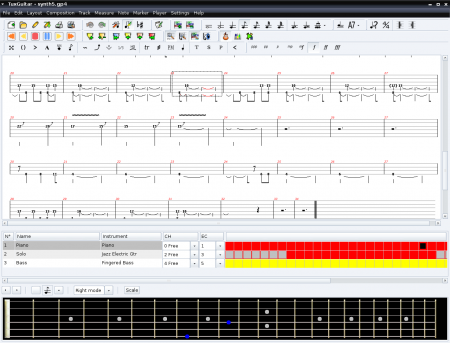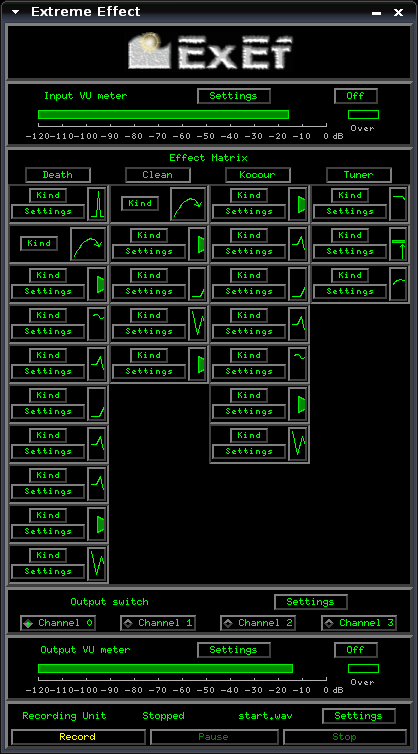Guitarism for linuksoid - why not?
A good friend of mine once said: “It is easier for linuksoids to learn to play the guitar.” - Because they are used to having to suffer for a long time, but then you enjoy the result.
He is certainly right. And below I want to look at some software designed to help a Linux guitar player on his difficult but incredibly interesting way.

TuxGuitar allows you to record scores and edit tablature. Supports Guitar Pro formats - .gp3, .gp4, .gp5 - and Power Tab Editor - .ptb. There is also a proprietary .tg format, although the default is to save files in .gp4 format. You can also work with MIDI.
')
On the Web, you can find tablature in one of the supported formats for almost every fairly well-known composition. For example, I have a catalog with tablature for all the songs of the Metallica group - I gradually get to know each other.
On some systems, TuxGuitar may not play the sound and generate the error "Unavailable Soundbank Error". The solution to this problem is described here .

Guitar tuner. Also known as KGuitune and QtGuitune, these are simply versions that use the QT graphics library instead of GTK. A playable note is displayed below. If anyone does not remember, in the standard structure, the notes for open strings look like this: e lectric b rain g oes d own a ny e rror (from first to sixth). On my guitar, by the way, the tuner shows the notes a little more precisely if you switch to one of the singles (and not to the humbucker). And on an acoustic guitar I noticed hint with the use of a small change in the relative position of the guitar and microphone when tuning the last two strings. So, I hope, the system keeps and you can move on to the last program for today.

And here is the software gadget for Linux. A sort of "soft distortion". For Linux, in principle, there are several programs of this kind, but this one differs in that it is very much ahead of all others.
First, the quality of the sound itself is very high - there is reverb and other effects that are so pleasant when playing with overloaded sound. Of course, to record this quality is not enough and can not be enough - for a “real” sound, you still need a piece of hardware, be it a combo or, say, a lamp pedal. But here, by the way, there is another advantage of Extreme Effect 'a: you can play and hear an overloaded sound and at the same time record a clean one. In practice, this makes it possible to record the necessary batches and, subsequently, “overload” them with iron equipment. You can also record and overloaded sound.
Another, the most important advantage of this program is the absence of delay. That is, we take the pick, extract the sound and immediately hear it overloaded. It may even be interesting for someone to delve into the source code and look at the implementation of this “real-time mechanism”. By the way, a rare case when the program is strongly recommended to run under the superuser, that is, by root, this allows the process to be given a high enough priority to save the user a lot of nerves.
In fact, we get probably the perfect solution in a situation where there is only a guitar and a computer. After all, not everyone who buys a guitar immediately buys a lotion (because it is much better to buy a good guitar and after a while a good combo than an average guitar and immediately an average combo), and besides, you can imagine a situation where a person takes a laptop and a guitar somewhere, and the combo does not go anywhere - and then it is precisely such programs that save.
He is certainly right. And below I want to look at some software designed to help a Linux guitar player on his difficult but incredibly interesting way.
Tuxguitar

TuxGuitar allows you to record scores and edit tablature. Supports Guitar Pro formats - .gp3, .gp4, .gp5 - and Power Tab Editor - .ptb. There is also a proprietary .tg format, although the default is to save files in .gp4 format. You can also work with MIDI.
')
On the Web, you can find tablature in one of the supported formats for almost every fairly well-known composition. For example, I have a catalog with tablature for all the songs of the Metallica group - I gradually get to know each other.
On some systems, TuxGuitar may not play the sound and generate the error "Unavailable Soundbank Error". The solution to this problem is described here .
gtkguitune

Guitar tuner. Also known as KGuitune and QtGuitune, these are simply versions that use the QT graphics library instead of GTK. A playable note is displayed below. If anyone does not remember, in the standard structure, the notes for open strings look like this: e lectric b rain g oes d own a ny e rror (from first to sixth). On my guitar, by the way, the tuner shows the notes a little more precisely if you switch to one of the singles (and not to the humbucker). And on an acoustic guitar I noticed hint with the use of a small change in the relative position of the guitar and microphone when tuning the last two strings. So, I hope, the system keeps and you can move on to the last program for today.
Exef

And here is the software gadget for Linux. A sort of "soft distortion". For Linux, in principle, there are several programs of this kind, but this one differs in that it is very much ahead of all others.
First, the quality of the sound itself is very high - there is reverb and other effects that are so pleasant when playing with overloaded sound. Of course, to record this quality is not enough and can not be enough - for a “real” sound, you still need a piece of hardware, be it a combo or, say, a lamp pedal. But here, by the way, there is another advantage of Extreme Effect 'a: you can play and hear an overloaded sound and at the same time record a clean one. In practice, this makes it possible to record the necessary batches and, subsequently, “overload” them with iron equipment. You can also record and overloaded sound.
Another, the most important advantage of this program is the absence of delay. That is, we take the pick, extract the sound and immediately hear it overloaded. It may even be interesting for someone to delve into the source code and look at the implementation of this “real-time mechanism”. By the way, a rare case when the program is strongly recommended to run under the superuser, that is, by root, this allows the process to be given a high enough priority to save the user a lot of nerves.
In fact, we get probably the perfect solution in a situation where there is only a guitar and a computer. After all, not everyone who buys a guitar immediately buys a lotion (because it is much better to buy a good guitar and after a while a good combo than an average guitar and immediately an average combo), and besides, you can imagine a situation where a person takes a laptop and a guitar somewhere, and the combo does not go anywhere - and then it is precisely such programs that save.
Source: https://habr.com/ru/post/14193/
All Articles